Abstract
1. The S,S (-)-enantiomer PD 129290, a kappa agonist, and its corresponding inactive R,R (+)-enantiomer (PD 129289) were studied in rat isolated hearts and in intact rats for cardiovascular and antiarrhythmic actions. The electrophysiological actions of PD 129290 were also studied in rat isolated cardiac myocytes using voltage clamp. 2. Ventricular pressure, heart rate and ECG were studied in isolated hearts while blood pressure, heart rate and ECG were studied in pentobarbitone-anaesthetized rats. In the latter, responses to electrical stimulation and coronary occlusion were also investigated. 3. In isolated hearts both enantiomers, over the concentration range 2-16 microM, dose-dependently reduced systolic ventricular pressure and heart rate while prolonging the P-R and QRS intervals of the ECG. 4. At doses of 1-32 mumol kg-1 both enantiomers reduced blood pressure and heart rate in anaesthetized rats. In addition, both enantiomers increased the size of the RSh and increased P-R, QRS, and Q-T intervals of the ECG. The thresholds for premature beats and ventricular fibrillation were dose-dependently increased by PD 129289. At lower doses PD 129290 decreased thresholds. These decreases were blocked by naloxone to reveal underlying increases similar to those seen with PD 129289. Both enantiomers increased refractory periods. 5. Naloxone (8 mumol kg-1) did not alter any of the actions of PD 129290, except to abolish the initial decreases in thresholds in intact rats seen with lower doses of PD 129290. 6. Both enantiomers (2 and 8 mumol kg-1) equally reduced arrhythmias in anaesthetized rats subject to occlusion of a coronary artery.(ABSTRACT TRUNCATED AT 250 WORDS)
Full text
PDF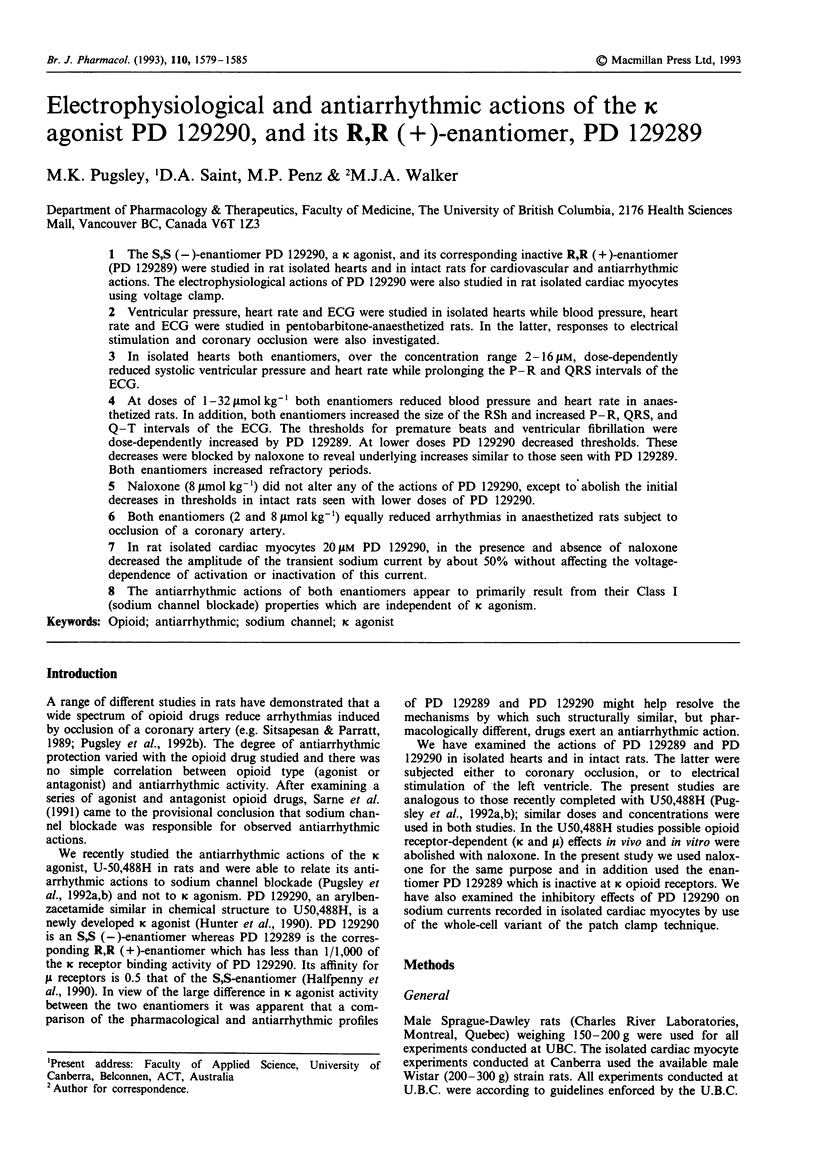
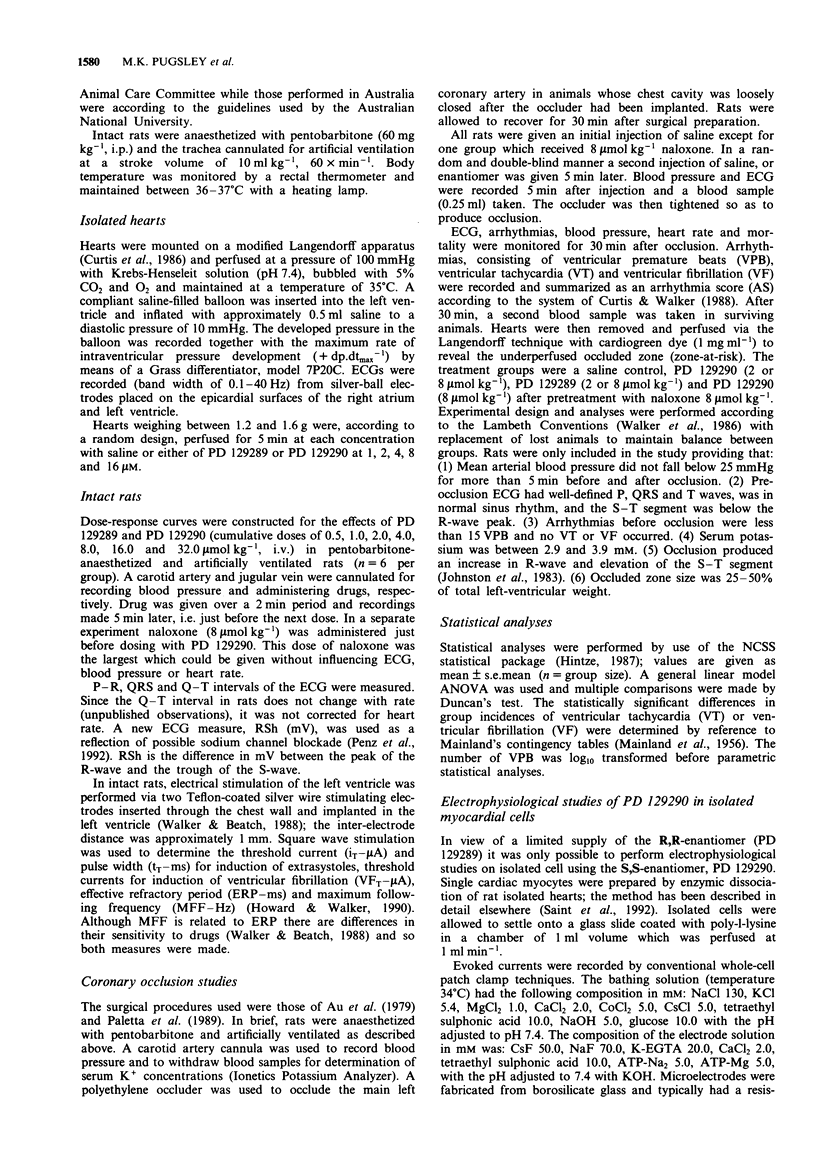
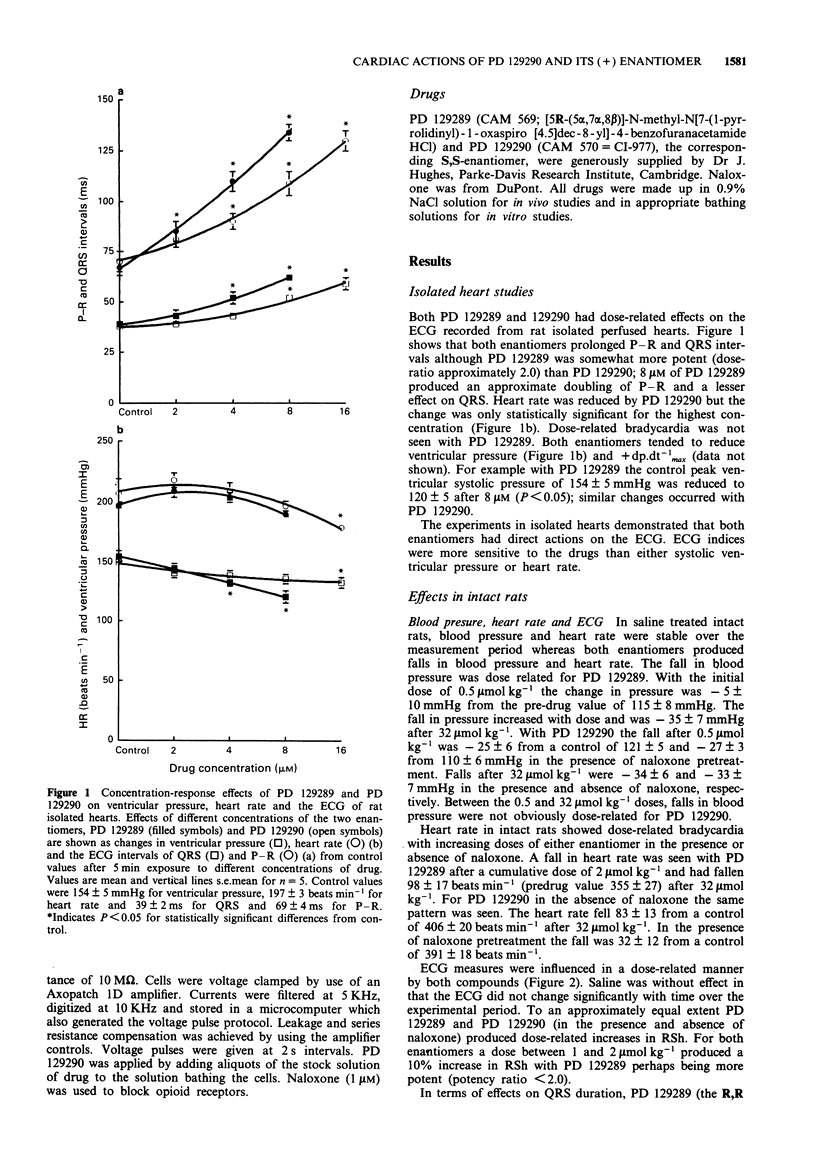
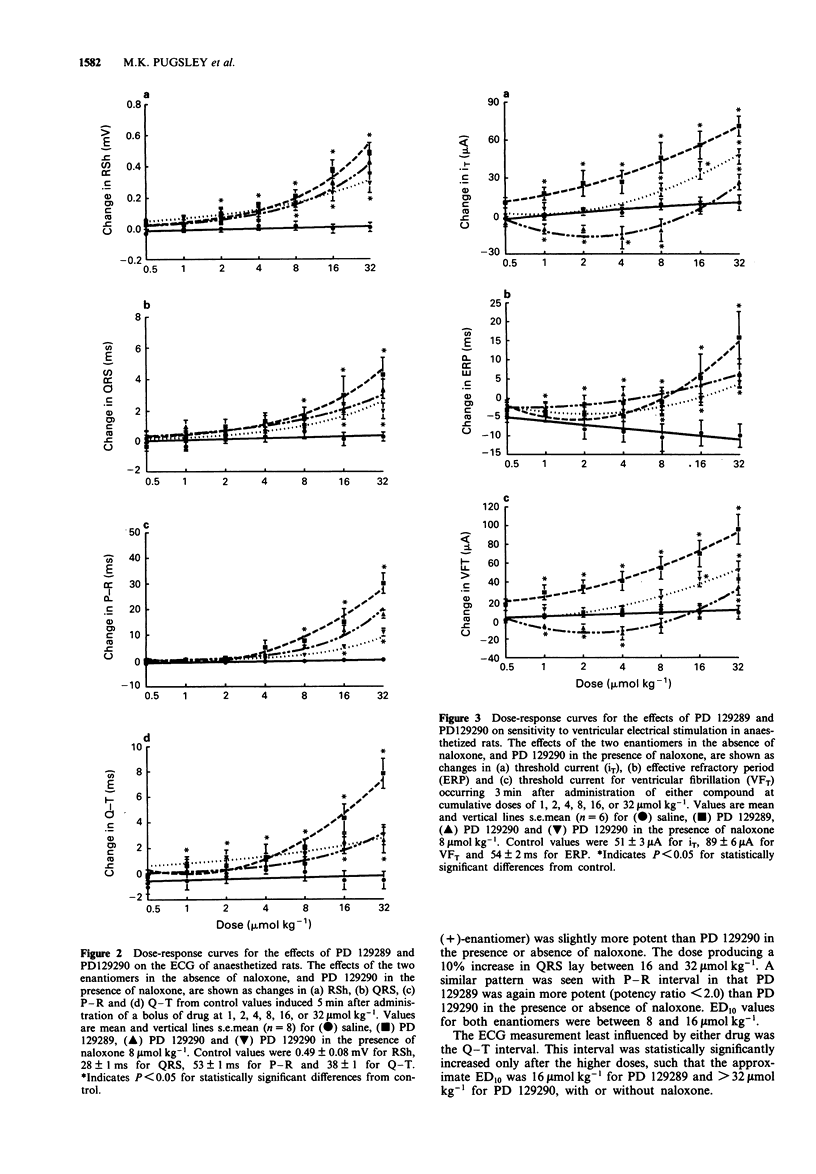
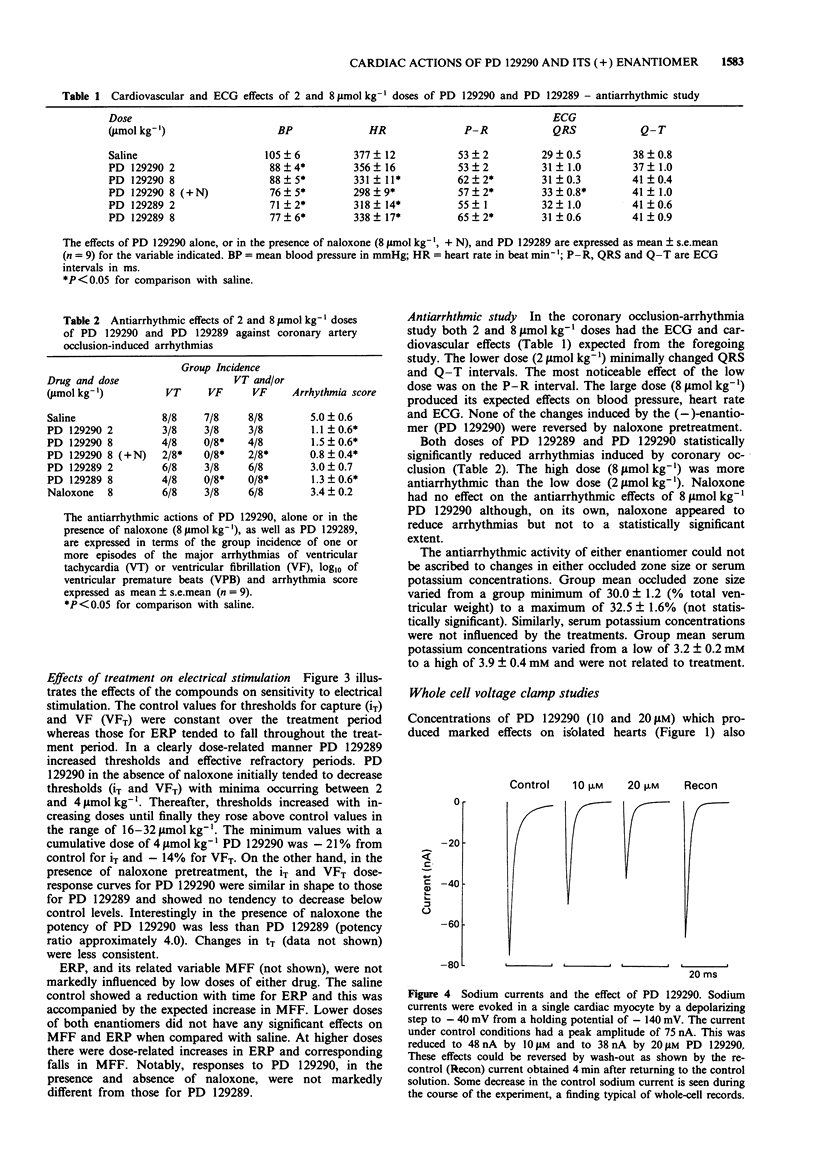
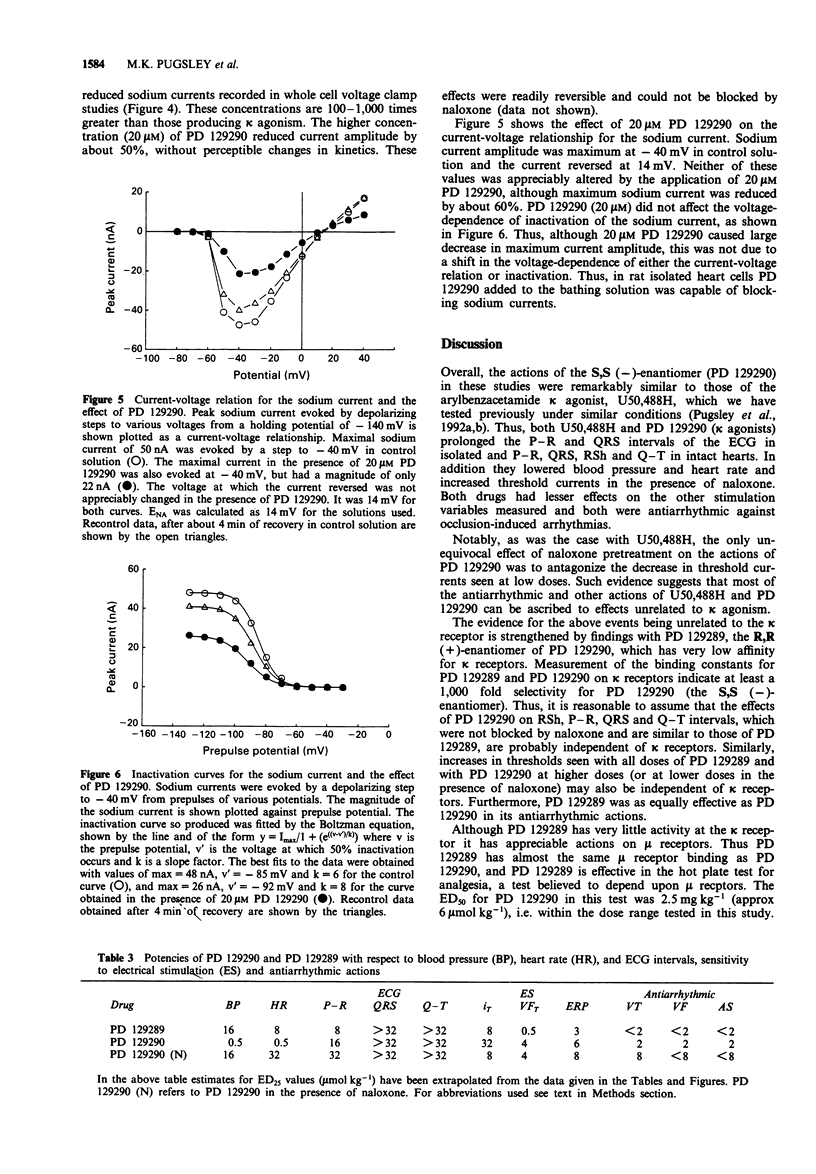
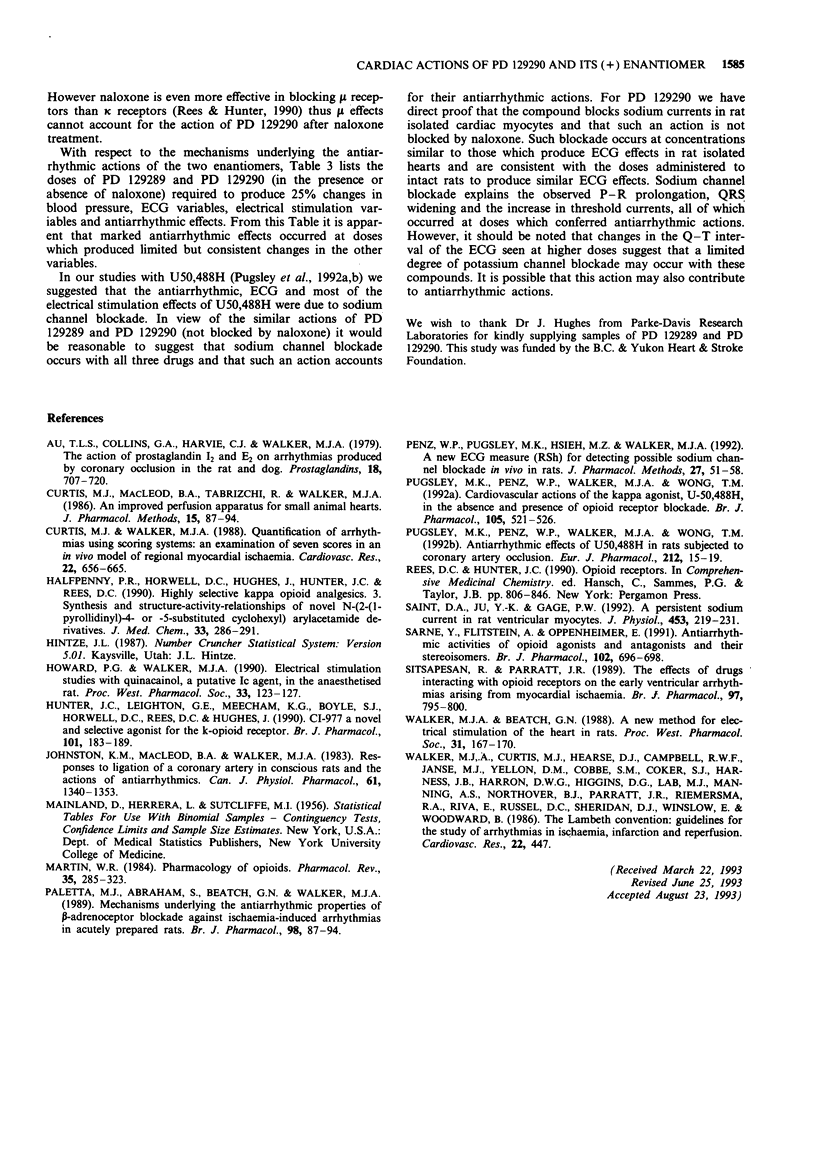
Selected References
These references are in PubMed. This may not be the complete list of references from this article.
- Au T. L., Collins G. A., Harvie C. J., Walker M. J. The actions of prostaglandins I2 and E2 on arrhythmias produced by coronary occlusion in the rat and dog. Prostaglandins. 1979 Nov;18(5):707–720. doi: 10.1016/0090-6980(79)90091-1. [DOI] [PubMed] [Google Scholar]
- Curtis M. J., Macleod B. A., Tabrizchi R., Walker M. J. An improved perfusion apparatus for small animal hearts. J Pharmacol Methods. 1986 Feb;15(1):87–94. doi: 10.1016/0160-5402(86)90008-2. [DOI] [PubMed] [Google Scholar]
- Curtis M. J., Walker M. J. Quantification of arrhythmias using scoring systems: an examination of seven scores in an in vivo model of regional myocardial ischaemia. Cardiovasc Res. 1988 Sep;22(9):656–665. doi: 10.1093/cvr/22.9.656. [DOI] [PubMed] [Google Scholar]
- Halfpenny P. R., Horwell D. C., Hughes J., Hunter J. C., Rees D. C. Highly selective kappa-opioid analgesics. 3. Synthesis and structure-activity relationships of novel N-[2-(1-pyrrolidinyl)-4- or -5-substituted-cyclohexyl]arylacetamide derivatives. J Med Chem. 1990 Jan;33(1):286–291. doi: 10.1021/jm00163a047. [DOI] [PubMed] [Google Scholar]
- Howard P. G., Walker M. J. Electrical stimulation studies with quinacainol, a putative 1C agent, in the anaesthetised rat. Proc West Pharmacol Soc. 1990;33:123–127. [PubMed] [Google Scholar]
- Hunter J. C., Leighton G. E., Meecham K. G., Boyle S. J., Horwell D. C., Rees D. C., Hughes J. CI-977, a novel and selective agonist for the kappa-opioid receptor. Br J Pharmacol. 1990 Sep;101(1):183–189. doi: 10.1111/j.1476-5381.1990.tb12110.x. [DOI] [PMC free article] [PubMed] [Google Scholar]
- Johnston K. M., MacLeod B. A., Walker M. J. Responses to ligation of a coronary artery in conscious rats and the actions of antiarrhythmics. Can J Physiol Pharmacol. 1983 Nov;61(11):1340–1353. doi: 10.1139/y83-193. [DOI] [PubMed] [Google Scholar]
- Martin W. R. Pharmacology of opioids. Pharmacol Rev. 1983 Dec;35(4):283–323. [PubMed] [Google Scholar]
- Paletta M. J., Abraham S., Beatch G. N., Walker M. J. Mechanisms underlying the antiarrhythmic properties of beta-adrenoceptor blockade against ischaemia-induced arrhythmias in acutely prepared rats. Br J Pharmacol. 1989 Sep;98(1):87–94. doi: 10.1111/j.1476-5381.1989.tb16866.x. [DOI] [PMC free article] [PubMed] [Google Scholar]
- Penz W., Pugsley M., Hsieh M. Z., Walker M. J. A new ECG measure (RSh) for detecting possible sodium channel blockade in vivo in rats. J Pharmacol Toxicol Methods. 1992 Mar;27(1):51–58. doi: 10.1016/1056-8719(92)90021-r. [DOI] [PubMed] [Google Scholar]
- Pugsley M. K., Penz W. P., Walker M. J., Wong T. M. Antiarrhythmic effects of U-50,488H in rats subject to coronary artery occlusion. Eur J Pharmacol. 1992 Feb 25;212(1):15–19. doi: 10.1016/0014-2999(92)90066-d. [DOI] [PubMed] [Google Scholar]
- Pugsley M. K., Penz W. P., Walker M. J., Wong T. M. Cardiovascular actions of the kappa-agonist, U-50,488H, in the absence and presence of opioid receptor blockade. Br J Pharmacol. 1992 Mar;105(3):521–526. doi: 10.1111/j.1476-5381.1992.tb09012.x. [DOI] [PMC free article] [PubMed] [Google Scholar]
- Saint D. A., Ju Y. K., Gage P. W. A persistent sodium current in rat ventricular myocytes. J Physiol. 1992;453:219–231. doi: 10.1113/jphysiol.1992.sp019225. [DOI] [PMC free article] [PubMed] [Google Scholar]
- Sarne Y., Flitstein A., Oppenheimer E. Anti-arrhythmic activities of opioid agonists and antagonists and their stereoisomers. Br J Pharmacol. 1991 Mar;102(3):696–698. doi: 10.1111/j.1476-5381.1991.tb12235.x. [DOI] [PMC free article] [PubMed] [Google Scholar]
- Sitsapesan R., Parratt J. R. The effects of drugs interacting with opioid receptors on the early ventricular arrhythmias arising from myocardial ischaemia. Br J Pharmacol. 1989 Jul;97(3):795–800. doi: 10.1111/j.1476-5381.1989.tb12018.x. [DOI] [PMC free article] [PubMed] [Google Scholar]
- Walker M. J., Beatch G. N. Electrically induced arrhythmias in the rat. Proc West Pharmacol Soc. 1988;31:167–170. [PubMed] [Google Scholar]


